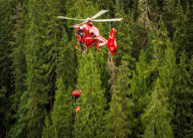
Is your company ready for an emergency? Emergencies can happen anytime, anywhere—but in BC’s forestry industry, where remote locations and difficult terrain are becoming more commonplace, being prepared isn’t optional. It’s essential. Having a well-thought-out and thoroughly tested Emergency Response Plan (ERP) can make all the difference—especially during The Golden Hour – where every second counts.
WorkSafeBC mandates that employers should be prepared for an emergency as part of their regulatory and legal compliance. Companies are required to create site-specific ERPs related to their operations and need to consider and prepare for various emergency situations. They are also required to conduct regular emergency and first aid drills as part of their annual drill requirements to ensure workers understand their roles and responsibilities.
 As forestry operations in BC move into more remote and rugged areas, getting help to an injured worker quickly can be a serious challenge. In some cases, it’s a matter of life or death where every second counts. To help companies build stronger ERPs—especially when it comes to worker extraction—the BC Forest Safety Council (BCFSC) and the Trucking and Harvesting Advisory Group (TAG) created a video series. These videos walk through real-life scenarios to help employers understand how to verify the effectiveness of their plans and spot any weak points to make critical improvements.
As forestry operations in BC move into more remote and rugged areas, getting help to an injured worker quickly can be a serious challenge. In some cases, it’s a matter of life or death where every second counts. To help companies build stronger ERPs—especially when it comes to worker extraction—the BC Forest Safety Council (BCFSC) and the Trucking and Harvesting Advisory Group (TAG) created a video series. These videos walk through real-life scenarios to help employers understand how to verify the effectiveness of their plans and spot any weak points to make critical improvements.
Emergency Response Plan Video Series
Equipment Rollover and Operator Extraction Procedures – this video features a logging crew conducting an emergency extraction drill and demonstrates the process and tools used for a crew-initiated extraction as well as a self-extraction done by the operator inside an over-turned cab.
Operator Extraction and Steep Slope Rescue Drill – this video demonstrates some challenges that crews could consider and be prepared for during a steep slope rescue.
Air Medivac Procedures Part 1: Planning Requirements – this video covers planning requirements for the helicopter evacuation of a critically injured worker.
Air Medivac Procedures Part 2: Practice Drills – this video covers the helicopter evacuation of a critically injured worker by two means of extraction: the helicopter landing and a long-line.
If you would like to learn more about Emergency Response Planning and conducting emergency drills, visit the BCFSC website or contact BCFSC Transportation and Northern Safety by email at transport.admin@bcforestsafe.org.